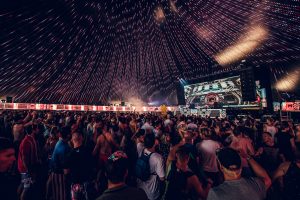Tech Focus: Immersive Sound — Sports Venues Eye Live Versions
New PA technologies could help attract fans to the stands
Story Highlights
Immersive sound has been moving along dual tracks in recent years. Formats like Dolby’s Atmos and Fraunhofer Institute’s MPEG-H have made deep strides into broadcasting, and music-touring artists are taking live-sound versions of immersive systems on the road, as Childish Gambino has done with L-Acoustics’ L-ISA platform.
However, immersive broadcast-sound formats have been using sports as the tip of the spear, and the venues in which games take place may become the next breeding ground for live-sound versions of the immersive concept.

Tomorrowland electronic-music festival worked with L-Acoustics to design a 20.1 L-ISA system to elevate the concert experience at Atmosphere Stage in Belgium.
“Some teams and both indoor arenas and outdoor stadiums have started experimenting with multichannel sound effects, although, to date, it has not gained wide acceptance,” observes Mark Graham, associate principal, A/V-systems consultancy WJHW. “But, as the technology advances and the costs come down, we do expect to see more interest” as part of venues’ strategies to attract to the stands those fans who otherwise stay home and watch/listen on surround systems.
The first indications that immersive sound is coming to sports venues are starting to appear. For one, integrator Diversified is working with WJHW on the Texas Rangers’ new park, Globe Life Field, expected to open in spring 2020. There, Diversified’s approach to providing some types of surround effects uses cross-firing loudspeaker arrays for localization and show-control software to manage it.
“I think there is huge potential,” says Justo Gutierrez, director, A/V and sound for sports and live events, Diversified. “But the size, scale, and acoustics of large venues pose technical challenges beyond the touring applications these immersive sound systems were designed for.
“The other challenge, of course, is the content creation,” he continues. “This is a case where the technology is there, but production staffs will need to catch up for producing and executing the content. Stadium PAs are predominantly mono, let alone stereo, so thinking in multichannel is quite a leap.”
The systems lining up for consideration are multiplying and offer cutting-edge technology that could make sitting in the stands at games almost as immersive as listening at home on a 5.1 or even an Atmos system. Here’s a look at some leading immersive live-sound candidates.
L-Acoustics
L-ISA combines processing, mixing and playback and is used in conjunction with the manufacturer’s loudspeakers. The audio is location-based, using the ear-brain combination’s natural localization capability. L‑ISA technology is enabled by a comprehensive hardware and software ecosystem that adds new tools — specifically the L‑ISA Processor and the L‑ISA Controller — to L-Acoustics loudspeakers, amplified controllers, and prediction and control software. In addition to providing traditional mixing tools, the system enables each sound object to be placed and manipulated anywhere within the 3D framework provided by the multichannel loudspeaker configuration. This object-based mix enables sources to be localized, scaled, and moved to their actual location or anywhere else within loudspeaker configuration. l-isa-immersive.com/live-sound/
Martin Audio
The Sound Adventures solution for providing immersive live-sound experiences is a 3D immersive audio technology developed in partnership with Belgium-based Astro Spatial Audio. Based on the SARA II Premium Rendering Engine and accompanying software, the object-based system lets users position and move audio sources in real time, as well as via timecode, cue-based, or tracking system. martin-audio.com/sound-adventures
d&b Audiotechnik
Based on delay-based localization, d&b Soundscape by d&b Audiotechnik in Germany delivers immersive audio via a combination of the manufacturer’s DS100 signal engine and Dante networking, using two software modules: d&b En-Scene, for sound-object positioning, allowing individual placement and movement of up to 64 sound objects; and d&b En-Space, an in-line room emulator that creates and/or modifies a space’s reverberation characteristics derived from acoustic measurements of seven critical performance venues and convolved within its audio processor. www.dbsoundscape.com/global/en/concept/
Meyer Sound
D-Mitri is an integrated digital audio platform for mixing, playback, multichannel distribution, live-event control, and acoustic-space simulation. It comprises a series of hardware modules that can be used to design audio systems for a wide range of applications. An Ethernet network-based, modular system that encompasses the entire audio chain from microphone input to loudspeaker output, D-Mitri integrates sound reinforcement, simultaneous recording and playback, matrix mixing, digital-signal processing, multichannel surround panning, and show-control automation into a unified, programmable environment. Meyer’s Sound CueStation control software can access every D-Mitri feature and fully automate system operation while sharing control among multiple users. System interaction can be further customized using Python-based scripting. D-Mitri systems can be scaled for venues of all types and sizes, including sports arenas. meyersound.com/product/d-mitri/

